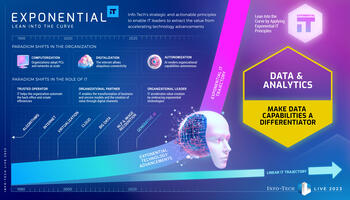- CIOs must be prepared for a volatile business environment in 2023, mitigating risks while simultaneously pursuing new growth opportunities with the right strategies and tactics.
- CIOs need to adopt technological trends that help the organization deliver value better and faster to compete in the digital economy.
- CIOs must build a structure to protect the organization from volatility and lay the foundation to thrive.
Our Advice
Critical Insight
- Like a chess grandmaster, CIOs must play both sides of the board. Emerging technologies present opportunities to attack while protecting from a volatile board state is a requirement.
- It’s the role of the CIO to push the organization harder. While maintaining existing technology, they must set goals for technology to support the business to move faster and perform better. To enhance existing capabilities and create new ones.
Impact and Result
- Use the data and analysis from Info-Tech's 2023 Tech Trends report to inform your digital strategy.
- Discover the seven trends shaping IT's path in 2023 and explore use cases for emerging technologies.
- Hear directly from leading subject matter experts on each trend with in-depth case study interviews.
Member Testimonials
After each Info-Tech experience, we ask our members to quantify the real-time savings, monetary impact, and project improvements our research helped them achieve. See our top member experiences for this blueprint and what our clients have to say.
9.0/10
Overall Impact
$12,999
Average $ Saved
10
Average Days Saved
Client
Experience
Impact
$ Saved
Days Saved
South African Reserve Bank
Guided Implementation
9/10
$12,999
10
Tech Trends
2023
Thinking like a chess grandmaster
Upon being defeated by IBM’s Deep Blue computer in a multi-game chess match in 1996, reigning world-champion and highest-ranked chess player in history Gary Kasparov cried foul. He accused the IBM team of cheating, saying that Deep Blue was in fact a Mechanical Turk of sorts, that humans were performing the job and not a machine. A documentary, Game Over: Kasparov and the Machine, was made detailing Kasparov’s accusations in 2003. But more than a decade later, Kasparov reflected on his experience differently in his 2017 book Deep Thinking. He retracts the cheating accusation and instead asserts that the moment was a watershed for artificial intelligence. In choosing to not reject technology’s capacity to beat him, he also embraces its potential to augment his capabilities when used as a tool.
“If we feel like we are being surpassed by our own technology it’s because we aren’t pushing ourselves hard enough, aren’t being ambitious enough in our goals and dreams,” Kasparov writes in the book. “Instead of worrying about what machines can do, we should worry more about what they still cannot do” (MIT Technology Review, 2017).
Technology leaders can sympathize. Like chess grandmasters, CIOs must strategize to defeat their opponents. Emerging technologies present opportunities to attack. Move your pieces the right way and you might establish a dominant position to support a victory. Defending the king is a constant concern, as the competition is constantly threatening to defeat you. Protecting from a volatile board state is a requirement.
Move the right pieces in the right way and win the day. Make a mistake and you risk toppling the king. Tech leaders must be prepared to respond to a range of different scenarios in a volatile business environment.
It’s the role of the CIO to push the organization harder. While maintaining existing technology, they must set goals for technology to support the business to move faster and perform better. To enhance existing capabilities and create new ones. They must test the limits of what machines still cannot do.
Make your move
Last year’s Tech Trends report focused on the capabilities organizations would need to compete in a digital economy. We are continuing that theme this year with four trends that are focused on helping the organization deliver value faster and better. At the same time, we’re considering the volatility of a world dealing with several major crises simultaneously. Organizations need to protect themselves from that volatility in order to thrive. So, we have three trends focused on the risks all organizations will face in the year ahead.
In Tech Trends 2023, we consider how technology leaders can attack opportunities while protecting the organization from the risks posed. We’ll consider which capabilities will help organizations respond to each trend in our CIO Priorities 2023 report to be published later this year.
CIOs would do well to heed Kasparov’s advice. If they fail to protect their organizations, crying foul play won’t help lessen the impacts of defeat. Better to focus instead on how to work with the machines and push harder toward achieving goals in collaboration. CIOs need to be ambitious and ready to make their move to push their organizations ahead.
Methodology
The research effort for Tech Trends 2023 is driven by our Trends and Priorities survey receiving 813 total responses from IT professionals between August 9 and September 9, 2022. See our methodology section for a full demographic breakdown of the survey. Each trend features a case study with an expert that is on the cutting edge of the trend, with Info-Tech conducting the interviews directly.
Design
Info-Tech’s design team created the visual elements of this report using AI-image generator Midjourney. See our generative AI trend to learn more about the creative potential of this emerging technology.
“Like a chess grandmaster, CIOs must play both sides of the board. Emerging technologies present opportunities to attack, while protecting from a volatile board state is a requirement.”
Attack New Opportunities
The Metaverse
Generative AI
Industry-Led Data Models
Sustained Digital Processes
Protect From Volatility
ESG Analytics and Reporting
Zero-Trust Security
Recession Preparation
The Metaverse
A platform that combines multiple technologies to enable social and economic activity in a digital world that is connected to the physical world.
Generative AI
AI can be trained by feeding content into generative adversarial networks, transformers, and variational autoencoders to create new content that’s meaningful to people.
AI investment on the rise

Generative AI is a type of semi-supervised machine learning that uses neural networks to create new content or interpret complex signal information. By training the models with a large amount of content, they can be made to generate new works like what people would create.
The uses for generative AI go beyond creating imagery. It could help businesses with predictive maintenance or improving cybersecurity analytics. It could help generate new ideas for drugs or assist in quality analysis and medical diagnoses.
AI is picking up steam with more organizations adopting it in 2023. According to our survey, AI will receive the most net-new investment by organizations by the end of 2023. While 35% of organizations say they have already invested in it, 44% of organizations say they plan to invest in it next year. With a 9% change between committed investment and planned investment, AI leads all technologies, followed by data lake at 5% and data mesh at 5%.
The change between organizations that are planning to invest in an emerging technology and those who have already invested in it.
signals AI used to unearth insights and handle repetitive tasks
By the end of 2023, most businesses plan to use AI for business analytics or intelligence, with 65% saying they will do so. Also, 63% of businesses say they will use AI to automate repetitive and low-level tasks. Other uses feature a clear drop-off after that, but the next-most popular use for AI is to identify risks and improve security.
By the end of 2023, which of the following tasks will involve AI at your organization?

Generative AI can play a role in enhancing each of the top three use cases of AI. Many businesses struggle with making use of unstructured data for analysis. Generative AI can interpret that data and transform it into structured data. That not only renders it usable in analytics but trainable for robotic process automation (RPA). Generative AI can also detect anomalies in network and application behavior, aiding security systems in identifying threats.
We also asked what AI governance steps organizations have in place today. New legislation in various jurisdictions, including Canada and Europe, are defining new rules around when and how AI can be applied. Organizations that are using AI in situations that governments determine to be high risk will be required to do more to mitigate risks. Yet today, 55% of organizations are doing nothing to govern AI. As more organizations invest in AI and start applying it to more decision-making processes, IT leaders should be putting governance structures in place before they’re made to do so by new regulations.
drivers Data needs to be collected and synthesized

The NEED TO MANAGE UNSTRUCTURED DATA
In the age of data collection in hope of becoming more data-driven in their processes, organizations are grappling with how to manage unstructured data. Unstructured data is the majority of data collected, describing everything from written communications to images to presentation decks. Basically, everything that’s not in a database or spreadsheet. Without AI to make sense of it, businesses can’t search this information and turn it into actionable insights.

NOT ENOUGH DATA
In some areas of business, the problem is a lack of the specific data they need to train an algorithm. The medical field often faces this problem because of the sensitivity of patient data. One solution to this problem is to create synthetic data: data that is generated by AI that closely approximates a real example of that data. Synthetic data is being used today to train various AI algorithms, from models that will detect brain tumors on an MRI scan to self-driving cars.

DESIRE TO COMPETE
Organizations are increasing their spending on AI because of the potential benefits it offers. It can augment workers to do more work more quickly, reducing costs by automating away more tasks. It can help discover new products more quickly and increase revenues. With more commercialized options available to deploy generative AI and more organizations investing, those that don’t invest may fall behind.
Attack opportunity – protect from risk Harness unstructured data, stay ahead of regulators
Opportunities
Augment your workforce
Some workers may fear that AI tools will replace them. Send the message that like any other tool, AI is meant to augment the work of people. With the availability of AI tools to consumers through the web, workers will start tapping into them for help with their work whether IT is involved or not. Consider how to help support a plan that is best aligned with the business and avoids potential risks.
Use synthetic data to improve your own AI models
If training specific models could be useful for your business for tasks like quality control or building customized marketing campaigns, then generating synthetic data could help accelerate the training of those models.
Make sense of unstructured data
Turn the volumes of unstructured data you collect and store into a useful asset. Use AI to read data stored in images, communications, and other content and translate it into a format that can be properly deciphered.
Risks
Beware of biased results
Society has ingrained biases, and since AI is trained on data from the real world, it will be biased as well. Being intentional about the data sets that train algorithms can help with this, and testing should be employed to uncover biases.
Put governance in place now
New legislation being developed in Canada and the European Union focuses on mitigating risks for high-risk AI applications. Draft legislation suggests requirements to use AI models that are explainable, to monitor deployed AI to ensure it’s behaving as expected, to conduct impact assessments on AI, and to publish clear explanations of how AI is intended to be used and what predictions it makes.
Consider ethical implications
Adopting a commercial AI tool that was trained on data of unknown origin may prove problematic. After image generators became popular in 2022, some artists complained that they’d never given permission to have their art used to train the AI models and that their own work was being devalued as a result of so many people using their style to produce new images. Getty Images banned the sale of AI-generated images on its service due to concerns about the legality of the images and their copyright (Ars Technica, Sept. 2022).
Attack opportunity – protect from risk Harness unstructured data, stay ahead of regulators

Generative AI causes controversy
When considering the risks of adopting AI, consider some of these AI controversies covered by the media in 2022. How could your organization avoid receiving unwanted attention like this?
In April, OpenAI releases its DALL-E 2 image generator, which produces biases that reinforce stereotypes. For example, women were more likely to be depicted as nurses, and men were more likely to be depicted as builders. OpenAI releases a fix to improve its image diversity, but then users find it is less accurate at turning their prompts into useful images (NBC News, 2022).
In June, Google engineer Blake Lemoine claims that chatbot LaMDA is sentient and publishes an existential conversation he had with the bot to the web. He is later fired (Washington Post, 2022).
In August, Jason Allen won Colorado State Fair’s fine arts competition with a piece generated using AI image generator Midjourney, titled Théâtre D’opéra Spatial, stoking controversy among artists (The New York Times, 2022).
case study From existential crisis to exciting collaboration
“I asked myself ‘How can I have authorship in this process when the rendering is done by a computer?’ The answer was that I viewed it as a collaboration with the AI.” Rob Sheridan
Art Director, Co-Founder
Glitch Goods
on his experience testing AI image-generating bot Midjourney
Situation
AI lab Midjourney launched its first product, an image-generating bot only accessible through Discord, to private beta in the first quarter of 2022. Similar to other AI-powered image generators like OpenAI’s DALL-E 2, it took any text prompt and produced an array of images. Midjourney’s illustrative aesthetic made it eye-catching, and it was soon featured on the June cover of The Economist.
While it was in private beta, the Midjourney team reached out to established visual artists to invite them to try the tool. Among them is Rob Sheridan, an American graphic designer best known for his work with the Nine Inch Nails, producing album cover art and other accessories for projects like Year Zero. In his first weekend of using Midjourney, Sheridan found himself in an existential crisis pondering what it meant for his role as an artist. “How can I have authorship in this process when the rendering is done by a computer?” he asked himself.
Sheridan responded by probing the limits of the AI image generator tool, testing the boundaries of where it would take his preferred genre of horror. After sharing some attention-getting results of his efforts to Twitter, Midjourney responded by banning terms like “body horror” from the platform. Sheridan doesn’t agree with the censorship. “Art is not just about beauty, that’s not a unilateral thing,” he says. “Beautiful is horror imagery to me. But it’s their platform so they can decide.”
Action
Despite the disagreement, Sheridan moved on from his initial reaction to Midjourney and used it for a new project, Volstof Institute for Interdimensional Research. A graphic story told on Instagram and Twitter, it’s a found materials narrative that’s firmly in the horror genre, with visuals of dilapidated laboratories, tentacles, and skulls. As Sheridan created more of the work, he began to appreciate the tool. “I love the flawed, messed-up aesthetic of it,” he says.
The project helped him come to terms with the implications of AI-generated imagery. He viewed the Volstof project as a collaboration between himself and the AI. He let the boundaries and parameters of Midjourney help guide his process and take the idea in new directions. The project has a modest following on social media but has been covered by the media, and some observers suggested the narrative would be fitting for a video game.
Sheridan also used Midjourney to produce elements for designs he sells on T-shirts and paraphernalia on his e-commerce store. While Sheridan doesn’t allow the AI to design everything on a new t-shirt, he did use it to create some characters that he incorporated into the design. “It’s exciting and I feel I can take some authorship of it,” he says. He points out that having the tool opened the door to him creating the designs on a whim, when otherwise he might not have invested time into following through on the idea.
Result
Sheridan’s advice to other artists is to adapt to the new set of tools. Art directors should be excited because they can now prototype designs more quickly, he says. “I can prototype something like Volstof without having to hire a team of artists or investing the time it would take me to do it manually.”
Illustrators can use the new tools as an extension of their own brains, he says, and eventually even train algorithms to mimic the style of their own work.
Don’t just look at all the problems with the new technology and dismiss it or demonize it, he advises. Film photographers that reacted that way to digital photography and photoshop were quickly pushed out of the market for the new standard that customers expected. While there will no doubt be problems to solve with Midjourney and other similar tools, it’s better to discuss how to solve those problems and work with technology providers. After all, in Sheridan’s view, the medium is not the message. “Having a good vision is more important than owning an expensive piece of equipment,” he says. Likewise, having a good vision will serve artists well as the unimaginative churn out volumes of banal imagery.
what’s next? Every creative field will be impacted by AI

Speech recognition
OpenAI’s stated mission is to pursue artificial general intelligence. As a result, it has several types of AI projects in progress. On Sept. 21, 2022, it released to open source Whisper, a neural net that can recognize English speech with human-level robustness and accuracy. It encourages developers to use Whisper to add voice interfaces to their applications (OpenAI, 2022).
Fraud detection
Identifying a user through digital data minutiae of how they move a mouse or what network their smartphone is connected to at the moment is now possible with AI-developed fraud prevention algorithms. The smallest details can be added up in an algorithm that predicts the risk of fraud on any given transaction and flags it for further inspection by a human (IT Business Edge, 2022).
Software development
Non-technical workers will be aided in creating new applications with AI-powered tools that write the code for them. GENIO is one example, described as a low-code software development program. It can generate code in both modern web architectures and back-office solutions. In a Facebook post, Meta CEO Mark Zuckerberg wrote, “It’s much harder to generate video than photos because beyond correctly generating each pixel, the system also has to predict how they’ll change over time.” Currently no one is allowed access to the model outside of Meta (The Verge, Sept. 2022).
“It’s much harder to generate video than photos because beyond correctly generating each pixel, the system also has to predict how they’ll change over time.”
Video
Meta unveiled its Make-A-Video system on Sept. 29, which allows users to type in words to describe a scene to generate a video several seconds long that matches the prompt.
Also important to watch will be the progress of new legislation to regulate AI. Bill C-27 is currently scheduled for a second reading in the House of Commons and could progress into law by the end of 2023. The EU-proposed regulation on artificial intelligence is expected to take longer to pass into law. So Canada may end up being the first jurisdiction to pass AI regulation to law in the world (McCarthy Tétrault, 2022).
recommendations and resources Train your own AI and experiment with it
Experiment with new generative AI tools
Whether it’s using Midjourney to render the art of your entire flagship content piece, as Info-Tech has done with Tech Trends 2023, or using Github Copilot to help you through the next few lines of code that you write, begin building awareness of the different AI-powered content creation tools available. Expect workers outside of IT to start using them on an ad hoc basis and consider how you might support them or mitigate potential risks.
Curate your own data sets to train generative models
Generative AI models come ready to imitate the artistic style of Picasso or the sound of The Beatles, but they won’t be ready to create specific content that is relevant to your organization. Luckily, it can be trained to do so with a robust enough source of input data. Consider what data you currently own that is a value differentiator and think about how to prepare it to train an AI model.
Develop an AI center of excellence
Group together the best AI talent your organization has access to on a centralized team. Have them examine processes and determine where AI can be used to create the most value.

Info-Tech Resources
Legal Professional Services Artificial Intelligence Report
It should come as no surprise that AI has gained traction in the legal professional services industry, as the benefits and return on investment (ROI) of AI is readily apparent. Automation of manual tasks, such as filing, categorization, document creation, and billing, is among the most visible benefits of AI, but this is just the tip of the iceberg.
Get Started With Artificial Intelligence
Use this blueprint to understand what AI really means in practice and to get started with your AI explorations to harness its transformative power.
AI and the Future of Enterprise Productivity
Artificial intelligence (AI), as a collection of techniques rather than a singular technique, sits at various levels of expectation and deployment – with some applications commonly deployed in enterprises for years and others just emerging.



 Define Your Digital Business Strategy
Define Your Digital Business Strategy
 Become a Transformational CIO
Become a Transformational CIO
 Kick-Start IT-Led Business Innovation
Kick-Start IT-Led Business Innovation
 Establish a Foresight Capability
Establish a Foresight Capability
 Apply Design Thinking to Build Empathy With the Business
Apply Design Thinking to Build Empathy With the Business
 Prototype With an Innovation Design Sprint
Prototype With an Innovation Design Sprint
 Sustain and Grow the Maturity of Innovation in Your Enterprise
Sustain and Grow the Maturity of Innovation in Your Enterprise
 Position IT to Support and Be a Leader in Open Data Initiatives
Position IT to Support and Be a Leader in Open Data Initiatives
 Double Your Organization’s Effectiveness With a Digital Twin
Double Your Organization’s Effectiveness With a Digital Twin
 Develop a Use Case for Smart Contracts
Develop a Use Case for Smart Contracts
 Adopt Design Thinking in Your Organization
Adopt Design Thinking in Your Organization
 Accelerate Digital Transformation With a Digital Factory
Accelerate Digital Transformation With a Digital Factory
 2021 Tech Trends
2021 Tech Trends
 Implement and Mature Your User Experience Design Practice
Implement and Mature Your User Experience Design Practice
 CIO Priorities 2022
CIO Priorities 2022
 2022 Tech Trends
2022 Tech Trends
 Into the Metaverse
Into the Metaverse
 Get Ahead of the Quantum Revolution
Get Ahead of the Quantum Revolution
 Demystify Blockchain: How Can It Bring Value to Your Organization?
Demystify Blockchain: How Can It Bring Value to Your Organization?
 2020 Tech Trend Report
2020 Tech Trend Report
 2020 CIO Priorities Report
2020 CIO Priorities Report
 CIO Trend Report 2019
CIO Trend Report 2019
 CIO Trend Report 2018
CIO Trend Report 2018
 CIO Trend Report 2017
CIO Trend Report 2017
 AI and the Future of Enterprise Productivity
AI and the Future of Enterprise Productivity
 Evolve Your Business Through Innovation
Evolve Your Business Through Innovation
 Build a Platform-Based Organization
Build a Platform-Based Organization
 Tech Trend Update: If Contact Tracing Then Distributed Trust
Tech Trend Update: If Contact Tracing Then Distributed Trust
 Tech Trend Update: If Biosecurity Then Autonomous Edge
Tech Trend Update: If Biosecurity Then Autonomous Edge
 Tech Trend Update: If Digital Ethics Then Data Equity
Tech Trend Update: If Digital Ethics Then Data Equity
 Industry-Specific Digital Transformation
Industry-Specific Digital Transformation
 Tech Trends 2023
Tech Trends 2023
 Formalize Your Digital Business Strategy
Formalize Your Digital Business Strategy
 Select and Prioritize Digital Initiatives
Select and Prioritize Digital Initiatives
 Adopt an Exponential IT Mindset
Adopt an Exponential IT Mindset
 Build Your Enterprise Innovation Program
Build Your Enterprise Innovation Program
 Build Your Generative AI Roadmap
Build Your Generative AI Roadmap
 Annual CIO Survey Report 2024
Annual CIO Survey Report 2024
 Drive Innovation With an Exponential IT Mindset
Drive Innovation With an Exponential IT Mindset
 Tech Trends 2024
Tech Trends 2024
 Exponential IT for Financial and Vendor Management
Exponential IT for Financial and Vendor Management
 Exponential IT for Strategy, Risk, and Governance
Exponential IT for Strategy, Risk, and Governance
 Exponential IT for Service Planning and Architecture
Exponential IT for Service Planning and Architecture
 Exponential IT for People and Leadership
Exponential IT for People and Leadership
 Exponential IT for Security and Privacy
Exponential IT for Security and Privacy
 Exponential IT for Applications
Exponential IT for Applications
 Exponential IT for Data and Analytics
Exponential IT for Data and Analytics
 Exponential IT for Infrastructure and Operations
Exponential IT for Infrastructure and Operations
 Exponential IT for Project and Portfolio Management
Exponential IT for Project and Portfolio Management